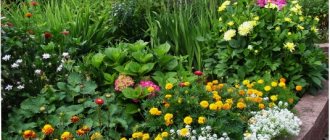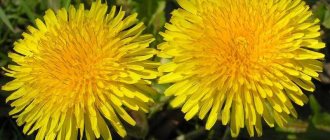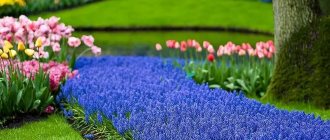Site development
Gardeners pay considerable attention to the aesthetics of their garden. And ever-blooming fragrant compositions can instantly transform an area, giving it a variety of colors and shapes. A flowerbed of continuous flowering with your own hands will require more effort than single plantings of one species. It is created according to very clear rules, from which it is undesirable to deviate, since harmony is lost, and the composition can become an object of irritation for the hostess, rather than receiving aesthetic pleasure.
- 1 How to make a flower bed that blooms all summer
- 2 Scheme for planting a flower bed of continuous flowering for beginners
- 3 What flowers to plant in a flowerbed so that they bloom all summer 3.1 Annuals for a flowerbed of continuous flowering
- 3.2 Perennials for continuous flowering beds
Scheme for planting a flower bed of continuous flowering for beginners
This video shows several schemes for planting flower beds of continuous flowering.
Ready-made schemes and designs for flower beds can also be found on gardening forums. But we must understand that the shape of the site may differ from the proposed type of design, not to mention the presence of certain plantings, both shrubs and trees, on the existing territory. And the visibility of the flowerbed from a certain angle depends on this. You also need to pay attention to the amount of light your plants will receive.
Scheme parameters vary:
- pyramidal;
- smooth, falling or decreasing in height on the sides;
- triangular (especially if there is a wall or corner of a building nearby that needs to be covered).
But there is always the possibility of a creative approach. The individuality of the composition is manifested both in the choice of plants and in their location, grouping, etc.
Perennial flower bed designs for beginners should include colorful flowering plants that will not blend into one spot. Therefore, contrasts or even halftones are used, sharply or softly flowing into one another.
Ready-made flower bed diagrams for beginners allow you to choose the most suitable plants for a set and determine their location in a specific area, but are not axiomatic. A creative approach is needed to accept the nuances of the territory and buildings, the presence of vegetation that is not planned to be eliminated.
Perennials for Siberia, blooming in spring
In order for the flowerbed to be decorated with flowers immediately with the first arrival of warmth, you need to focus on perennial primroses. The arrival of spring in Siberia will be signaled by snowdrops, incredibly delicate crocuses, and snow-white inflorescences of lilies of the valley. Perennial primroses are suitable for almost all northern latitudes, since their growing season is short. They will have time to bloom before summer.
Iris reticulum
The second name of the primrose is Iridodictium or Reticulata. The perennial belongs to the bulbous flower family. In the catalogs of flower companies selling seed material, there are irises under a different name: Juno and Xyphium. This is due to the fact that the perennial has several subspecies, each of which has different characteristics.
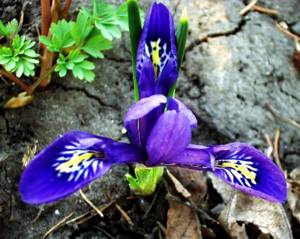
Height of blooming iris 15 cm
It is the Reticulated Iris that is characterized as a small-bulbous miniature ornamental plant. The height of the flower is only 15 cm, but it does not stay that way all the time. Flowering in Siberia begins simultaneously with all early primroses, and it lasts a maximum of two weeks. After the flower withers, the stem grows rapidly and stretches up to 25 cm in height. When a perennial finishes growing, it gradually withers and dies until the next season.
Scylla
The perennial is better known by the popular name “scilla”. A small and graceful primrose will decorate any spring flower bed. The flower belongs to the group of small-bulbous plants. Previously, the crop was classified as a member of the Asparagus family, but now it is classified as a member of the Lily and Hyacinth family. In the vast expanses of wild nature, the bluegrass has chosen the meadows. The perennial is found en masse in forests. There are up to 20 species of scilla, and each of them is suitable for growing in Siberia.
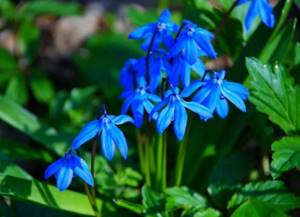
There are up to 20 species of Scylla
The plant is characterized by amazing vitality. Primrose does not require special growing conditions. The bulbs do not need to be dug up at the end of the season, unless if necessary they are propagated or transplanted to another place.
Advice! In order for a perennial to grow and delight with flowering for many years without special care, it needs to find a suitable place on the site.
Hyacinths
Primrose belongs to the bulbous plants, blooms well in the climatic conditions of Siberia. The height of the plant is about 40 cm. The decorative effect is provided by the lush inflorescence, reminiscent of a candle in shape, consisting of many small flowers. Even the leaves create the beauty of a perennial. In hyacinth they are long and thin. The leaves protrude like arrows through the lush decoration.
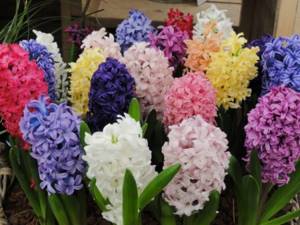
Hyacinth can be grown even on a windowsill
The color range is extensive. Hyacinths have been bred in white, yellow, purple and other colors. A perennial bulb can be planted in a flower pot and grown on a window for the women's holiday on March 8th.
Primrose
For Siberia, primrose is an excellent choice. The perennial will be one of the first to bloom in the flowerbed. Plant height is maximum 25 cm. The root grows along the surface layer of soil. Even the leaves of the perennial are decorative. They are elongated, slightly wrinkled, bright green in color with fine edges. To prevent foliage from hiding the flower, it grows on a long peduncle. The inflorescence is shaped like an umbrella.
Read more Garden early perennial flowers
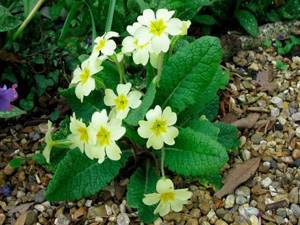
Duration of perennial flowering up to 8 weeks
Advice! Primrose in a flowerbed looks great in a composition with lilies of the valley and muscari.
The color of the flower is very different - from monochromatic to variegated colors. The advantage of primrose is its long flowering. The perennial primrose decorates the flowerbed for up to 8 weeks. The culture is unpretentious in care. The climate of Siberia is like home to her. It is enough for the flower to provide loose, moist soil and shade.
Narcissus
The popular perennial is associated with the arrival of spring. The proud primrose in Siberia begins to bloom around May, when the snow melts. The flower is yellow or white, attached to a peduncle, the length of which varies from 10 to 80 cm. The leaves are elongated, long, arrow-shaped. Each flower consists of strictly 6 petals.
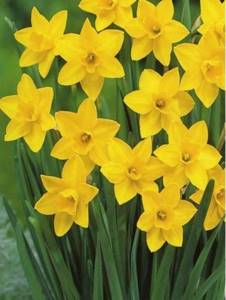
Daffodils don't like marshy areas.
In Siberian conditions, a flower bed is chosen for daffodils in an area where groundwater lies deeper than 60 cm. In swampy areas, the tips of the fibrous root die off. The perennial's growth is stunted.
What flowers to plant in a flowerbed so that they bloom all summer
A composition of unpretentious crops will give you a good mood throughout the spring-summer-autumn season - at least 7-8 months a year. And the fact that care for such a landing is minimal only makes it positive.
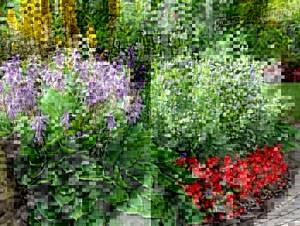
In your delights, you can focus on the color scheme. For example, a white flower bed of continuously blooming flowers will become a gentle accent to the entire area.
But when choosing plants, you should take into account the requirements for:
- soil;
- lighting;
- watering;
- drainage;
- fertilizers for all potential “tenants”;
Also, some fast-growing and climbing species will need to be pruned or planted with support nets. To do this, a scheme of paths is thought out to provide access to plants of this variety.
A set of seeds for a flowerbed of continuous flowering should include decorative foliage plantings, which, even in the presence of faded and unattractive bulbs, will decorate the garden, covering the unsightly predecessors with their colorful leaves. The same role can be played by cereal crops, the decorative value of which usually remains until frost.
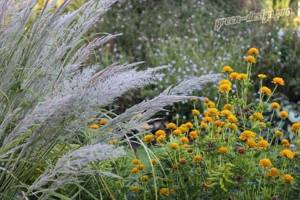
A win-win option would be a continuous flowering bed with peonies. These perennials are not demanding in care and, as they grow with age, they only improve the entire composition. But it is worth considering the fact that these plants need space and shade neighboring flowers with their fairly tall growth. One- and two-year-olds will help not to leave the area near the peonies empty until they spread their shoots.
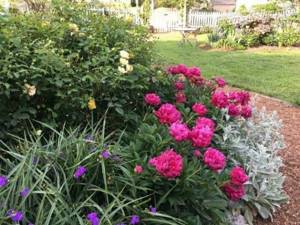
The composition can be stationary - with exclusively perennial plants.
There are many advantages of such landings:
- to study the requirements and draw up landing plans, you will need to go through the recommended plans and simply select the most relevant one;
- minimum time spent on care;
- novice gardeners have the opportunity to be proud of their achievements over the years.
But many gardeners like to change the composition from time to time. It can only be added as one- and two-year-olds, defining the accents of the current season, or by replanting perennials and expanding the flowerbed. It is important not to overdo it and not to thicken the area. A free layout does not exclude the presence of a general planting plan.
Annuals for continuous flowering beds
A composition for beginners, as an experimental point, could theoretically consist exclusively of annual plants. Then you won’t have to worry about failures, and already having experience, start planning in a new way in the spring.

Regardless of whether one- and two-year-olds will be a simple addition or become the basis of a flower bed for the entire season, even experienced gardeners recommend using them due to their high decorative value.
Annuals for a flowerbed of continuous flowering with names:
- alyssums;
- lobelia;
- asters;
- annual chrysanthemums;
- species of marigolds, zinnias;
- rich varieties of petunias;
- purslane;
- amaranth;
- decorative types of sunflowers with yellow, red and even light green colors;
- decorative corn;
- nasturtium;
- calendula;
- annual dahlias;
- hyacinth beans (Turkish beans).
Two year olds:
- varieties of bells and carnations;
- viols;
- daisies;
- foxgloves;
- mallows.
Low-growing annuals for a continuous flowering bed will hide unsightly faded areas and will not require effort to remove in the fall. They can also create a border. For example, decorative cabbage is used. Low annuals also help perennials retain moisture and can add aesthetic and olfactory pleasure with their scents.
Plant selection
The design of a flower garden, which is formed from perennials, may include other types of plants. As a rule, perennial plants do not bloom for long.
This fact must be taken into account and have ornamental grasses and individual plants with bright foliage “in stock”.
In this case, throughout the entire warm period, the flowerbed will retain its design appearance.
At the same time, it is important to make an accurate calculation of flowering times for the main elements of the composition
Blooming in spring
This list includes: lumbago, snowdrop, lungwort, phlox subulate, crocus, narcissus.
All these perennials do not require special care and tolerate residual spring frosts well.
Video:
Here you can also add carnations, irises, coreopsis, peonies, and cherry blossoms, which bloom until mid-June.
Blooming in summer
Here the list of perennials is much longer - delphinium, mallow, and paniculata phlox are unpretentious and resistant to hot weather.
This list also includes lilies, sage, holly, and purple coneflower.
There are many other flowers that will suit any flower bed.
Blooming in autumn
First of all, we need to name the aster, which grows in all climatic zones and blooms until the first snow.
Some of these perennials have flowers that are as bright as summer varieties.
Autumn perennial flowers for Siberia
Autumn in Siberia is accompanied by cold weather. However, even at this time of year you can grow beautiful flowers here. There are autumn perennials that bloom in late August or early September. Some of them are dug up and brought into the house to prolong flowering.
Chrysanthemum
The large family consists of more than 50 species. There are tall varieties that are often used to decorate terraces and flower beds, as well as low-growing plants planted along the borders of the beds. Tall chrysanthemums are used to make bouquets. The advantage of flowers is that they can stand in a vase with water for up to a month.
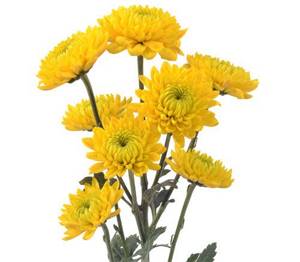
With the onset of severe frosts, the chrysanthemum can be transplanted into a flower pot and placed on a closed veranda, where it will bloom for a long time
The perennial blooms until late autumn. Even frost is not scary for him. However, in Siberia it is better to grow chrysanthemum as an annual. In winter, a root left in a flowerbed will freeze. Its owners usually transplant it into a flower pot, send it to the cellar to store, and plant it again in the spring.
Bush aster
The perennial begins to bloom in the vast expanses of Siberia from the end of August. Aster has a thin but strong stem. Flowers come in a variety of shapes: needle-shaped, double, ordinary and others. The color is similarly varied. The most common flowers are purple, pink, white, and red. Some varieties even have a combined color, for example, the edges are red and the center is white or yellow.
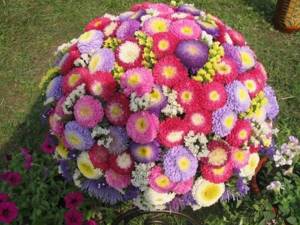
Asters bloom in Siberia beginning in late summer
The perennial loves a sunny, open area. Light, fertile soil with good drainage and neutral acidity is preferred. It is optimal to protect the flower bed from the wind.
Unpretentious perennials for Siberia
Growing flowers in a cold region involves a lot of trouble. This option does not suit lazy gardeners. Especially for such people, you can find perennials that are generally unpretentious and do not require special attention. They can simply be planted in a flower bed.
Dianthus grass
The herbaceous plant grows in the wild. This type of carnation is a ground cover. The plant grows over the ground in a thick carpet. The culture belongs to the group of unpretentious perennials due to the fact that it is able to grow and bloom without human intervention. However, the decorative effect is lost with a lazy growing method. Bushes look more beautiful if they are cared for.
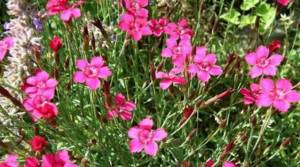
Carnations quickly grow in a flower bed without care
There are many varieties that differ in flower color. Pink, white and red are more common. There are even two-color carnations. Each flower consists of 5 petals with jagged edges. After flowering, a seed box is formed.
Astilbe
A perennial that grows as a subshrub is considered unpretentious for Siberia. The plant grows powerful stems up to 2 m high. The bush is thick with foliage. Its bright green color and jagged edges make it decorative. Several flower stalks are formed. They resemble panicles in shape. The color is lilac, pink or garnet. The duration of flowering in Siberia is up to 35 days.
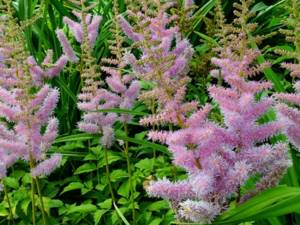
Subshrub grows in the shade
The sun is contraindicated for perennials. The burning rays leave burns on the inflorescences. It is better to plant the semi-shrub under the canopy of trees or in another shaded place. If the winter is not snowy, the plant needs to be covered so that the root does not freeze.

